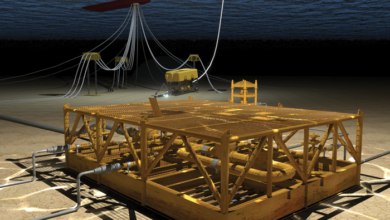Systems view to drilling recognizes the whole is greater than sum of parts
Integrated approach allows Schlumberger to better manage interdependency of discrete technologies, lower overall cost per barrel
By Joanne Liou, Associate Editor
Khaled Al Mogharbel is President of the Drilling Group at Schlumberger.
A long-standing goal across the industry is to lower operating costs while ensuring safe and compliant operations. Where does the industry stand today?
 Our industry has always been safety minded. With the drive for greater operational efficiency to lower costs, the industry as a whole is continuing to advance safety practices in all operations. At Schlumberger, we empower employees to intervene and stop any practice they deem unsafe.
Our industry has always been safety minded. With the drive for greater operational efficiency to lower costs, the industry as a whole is continuing to advance safety practices in all operations. At Schlumberger, we empower employees to intervene and stop any practice they deem unsafe.
The Schlumberger Drilling Group is continually working to lower the cost per barrel by focusing on three areas: improving drilling performance and increasing efficiency; providing a stable and safe wellbore that can be accessed at all times and with intervention, as needed; and precise positioning of the wellbore for maximized reservoir contact.
Among the three focus areas – drilling performance, wellbore assurance and well placement – does one take precedence over the others?
All three are important; however, the area of focus depends on the well. In unconventional resources, efficiency is key. In deepwater, providing a high level of well integrity is crucial to ROI. Characterization is essential for all reservoirs – we are a data-driven industry, so despite the number and kinds of measurement available today, our customers continue to ask for more data and information to further minimize uncertainty. Today, customers not only want to measure rock and fluid properties near the wellbore, they also want to measure what’s ahead of and around the wellbore while drilling. We’re doing that with our GeoSphere reservoir mapping-while-drilling service.
I understand that Schlumberger has adopted a fully integrated approach to the drilling business. What are the benefits?

Integration of drilling services enables improved drilling performance and reduced risk, which helps our customers reduce their overall cost per barrel. As an industry, not only do we need to integrate services in field operations at the wellsite, but we also need to integrate technologies and engineering workflows in the office. Let me share an example of an integrated operations project in the deepwater Gulf of Mexico.
The operator was planning to drill a high-risk exploration well with limited offset data to a measured depth of more than 25,000 ft. In this costly, high-pressure, high-temperature drilling environment, the primary goals were to minimize trips due to hole cleaning, BOP testing, tool failures or wellbore issues. With only two months to develop the complete plan, a multi-domain team of experts rapidly integrated workflows and modeled multiple scenarios, optimizing the drilling bottomhole assembly design, bit selection, drilling parameters, hydraulics, logging tools and real-time monitoring operations.
All six hole sections were drilled flawlessly, each in a single run, without any extra trips, saving the operator considerable rig time and achieving a well cost that was $18 million under budget.
What are the challenges to integrate the workflow?
For years, the industry has been applying discrete technologies, products and services. The next step-change will come from deploying these incremental changes from discrete products and services in an integrated drilling system or system-engineered approach. Some products – such as drilling fluids and bit performance – perform better when their interaction and dependence are understood.
Our approach is not only to invest in the development of discrete products and services for enhancements in drilling performance, but we are also investing in integration technologies that allow us to model the interdependency of such products and services. For example, we are now able to model the entire drillstring from bit to surface to allow us to better understand and manage the concurrent performance of the system with a holistic approach.
What role does automation play in this trend toward workflow integration?
The industry is still in the learning phase of automation. Right now, automation is mostly happening on surface and is done by drilling contractors. Schlumberger is interested in closing the loop between surface and downhole operations. However, automation does not belong solely with the service companies; true automation requires alignment among drilling contractors, rig equipment providers, service companies and operators.
Discussion at industry societies and associations, like the SPE Drilling Systems Automation Technical Section and the IADC Advanced Rig Technology Committee, are essential to aligning the various players who will need to work together to ensure an integrated workflow so that automation achieves the potential it has to offer our industry.
In July, Schlumberger and Precision Drilling announced an alliance to increase industrialization of unconventional drilling using Precision’s Tier 1 drilling rigs and Schlumberger’s bottomhole assembly and services. How would you describe that industrialization?
The Precision Drilling alliance allows us to access a new market. We and Precision Drilling believe that the North America land drilling market will move toward a general contractor model, a more construction-based, turnkey market. In this alliance, Precision Drilling is the general contractor, and Schlumberger provides the downhole technologies, operational training and equipment maintenance. We believe this alliance has the potential to increase drilling consistency and lead to a more industrialized process.
Given your extensive experience in the Middle East, what specific lessons have you learned from that region that you could apply elsewhere?
In the Middle East, the NOCs take a longer-term view on their plans. This longer-term focus allows us to more closely align with our customers’ goals and, as a result, locally invest in the people, support the infrastructure and develop the technologies that meet the challenges NOCs face.
In North America, the drivers are slightly different. In high-tier offshore projects, long-term commitments are typical. More recently, we are seeing some North American land operators create longer-term commitments to foster collaborative relationships because they realize the long-term benefits.
With advances in real-time technologies and an increase in amount of data being collected from oil and gas operations, what role can service companies play in data management?
The industry is entering an era of big data, and this is a very exciting time. Schlumberger has always managed data, and data security remains a top priority. However, another challenge lies in extracting the value of pertinent data in relevant time. We have millions of wells in our database, and we do 120,000 drilling simulations a month. One simulation used to take days. With the availability of our high-performance computing capabilities, now it takes hours, sometimes minutes.
We need to combine existing data via modeling and simulation with the real-time data flow to make decisions that inform the drilling process. Otherwise, it’s just stored data on a hard disc.
How would you define big data for this industry?
Big data started in the consumer space with digital transactions. For the industrial space, data challenges go well beyond size. Our industry data is complex, used in high-value decisions, generated from both people and machine operations, captured in multiple systems, and needs to be assessed both across time and the entire E&P chain.
For us, the goal is to bring unprecedented levels of efficiency and productivity in operations as has been achieved in the consumer space. Big data is an important component, as is better sensing, analytics, software platforms, mobility, human skills and efficiency – all coming together for better outcomes with safety and efficiency.
GeoSphere is a mark of Schlumberger.





